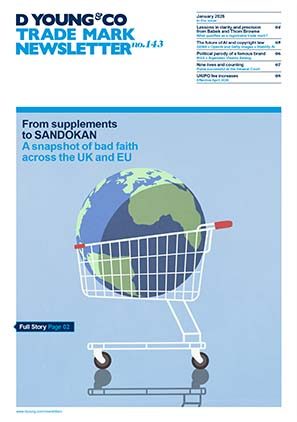UK High Court finds EAGLE RARE infringed by AMERICAN EAGLE
In Sazerac Brands LLC v Liverpool Gin Distillery Ltd and Halewood Group [2020] EWHC 2424 (Ch), the High Court found that UK and EU trade marks EAGLE RARE registered for bourbon whiskey were infringed by sales of bourbon whiskey under the brand “American Eagle”. The trade mark AMERICAN EAGLE for goods in class 33 was also declared invalid.
Background
The Sazerac Company, one of the two largest spirit companies in America, has been producing and selling a high quality Kentucky bourbon whiskey for almost twenty years under the name “Eagle Rare”. Eagle Rare is a prestigious bourbon and has won multiple awards including Best American Whiskey, Best Straight Bourbon Whiskey, Best Bourbon Whiskey and Best Kentucky Whiskey at The International Whisky Competition. Sazerac Brands LLC own several trade marks for EAGLE RARE in both the EU and UK in respect of class 33 covering alcoholic beverages, spirits, whiskey and bourbon.
The defendants were part of a company group whose CEO had created the “American Eagle” brand of Tennessee straight bourbon, sold in three versions: a four year old, an eight year old and a twelve year old. The twelve year old was launched in late February 2019, and this was used as the date at which the alleged infringement of the Eagle Rare trade marks was to be assessed. Halewood filed an application to register AMERICAN EAGLE as a UK trade mark for alcoholic beverages (except beers) and spirits, which proceeded to registration in September 2018.
The claimants sued the defendants for trade mark infringement under Sections 10(2) (likelihood of confusion) and 10(3) (unfair advantage) of the Trade Marks Act 1994 and the corresponding provisions of the EU Trade Mark Regulation (2017/1001).
Sazerac also challenged the validity of Halewood’s mark. The defendants sought revocation of Sazerac’s UK and EU trade marks on the grounds of non-use.
The case focused on two main issues:
- Whether the AMERICAN EAGLE sign is similar to the EAGLE RARE trade mark and used in relation to identical goods, namely bourbon whiskey, and whether there is consequently a likelihood of confusion on the part of the UK and EU public.
- Whether the sign AMERICAN EAGLE is similar to the trade mark EAGLE RARE, which has a reputation in the UK and in the EU, and whether the use of AMERICAN EAGLE takes unfair advantage of the distinctive character or repute of EAGLE RARE and/or is detrimental to its distinctive character.
Characteristics of the average consumer
In the first instance, Mr Justice Fancourt addressed the issue of identifying the average consumer. It was accepted that the average consumer in this instance is a consumer of bourbon whiskey. However, they were not a particular purchaser of a particular product. As a legal construct, the average consumer represented a range of characteristics of normal purchasers buying in various circumstances. The average consumer excluded consumers at either end of the knowledge and attentiveness spectrum (that is, those with no knowledge at all and connoisseurs). However, it included those who do not drink bourbon, but may purchase it as a gift.
It was accepted that there is a greater than usual degree of brand loyalty within the bourbon market and so, on average, the consumer has a somewhat higher degree of attentiveness than a consumer of other spirits.
Likelihood of confusion
Having established the average consumer, the court went on to objectively assess the likelihood of confusion using the principles as set out in Comic Enterprises Ltd v Twentieth Century Fox Film Corporation.
The EAGLE RARE mark was considered to comprise a distinct word, EAGLE, and a commonplace word particularly in relation to aged spirts, RARE.
On the other hand, with AMERICAN EAGLE, the word AMERICAN was considered a much stronger word than RARE so the mark would be read as a composite whole.
Conceptually and aurally the signs are different although it was admitted that there is some visual similarity.
Given that the average consumer is considered to have a higher degree of attentiveness and likely to have some brand loyalty, the court found that there would be no likelihood of confusion within a significant portion of the bourbon buying public.
Whilst direct confusion was unlikely – in that a purchaser of bourbon was unlikely to mistake a bottle of American Eagle for the more familiar product of Eagle Rare - the same consumer would, however, likely assume that there was some connection between them, judging by the degree of similarity in names and the relevant market. This was sufficient to constitute a likelihood of confusion (indirect confusion), despite there being no evidence of any actual confusion.
Reputation of EAGLE RARE
The court then turned to the second issue regarding EAGLE RARE’s reputation and the detriment to it, relying on the principles set out in General Motors Corporation v Yplon SA.
The parties were not in agreement as to the definition of the relevant public for the purpose of establishing reputation, more specifically whether the relevant part of the UK public was:
- that with contact with or exposure to the whiskey market generally; or
- that with contact with or exposure more specifically to the bourbon market.
The court concluded that it would “be illogical for the owner of the mark to have to prove a reputation in a field in which the mark has not yet been fully deployed, or deployed at all, if all that they were seeking to do was restrain infringement in a narrower field in which the mark had been used.”
The court concluded that although EAGLE RARE was sufficiently well-known to have a reputation in the bourbon market of the UK and EU and that a significant part of the market would be confused as to whether American Eagle and Eagle Rare come from the same or economically linked undertakings, use of AMERICAN EAGLE would not cause detriment to the distinctive character of the EAGLE RARE trade marks.
Any association with the claimant’s trade marks and their repute would not be harmful to the claimants. Whilst it may be frustrating that the claimants lose the only EAGLE association for whiskey in the UK and EU, the claimants are not entitled to a monopoly over that word.
Takeaway points from this case
Halewood’s use of AMERICAN EAGLE was found to infringe Sazerac’s EAGLE RARE mark and Halewood’s mark was declared invalid.
This case highlights that whilst there may be a successful finding of a likelihood of confusion, distinctive character and reputation of a mark, it does not automatically follow that there is an unfair advantage or detriment.
This judgment also provides useful insight into the court’s determination of key issues such as the average consumer and the nature of the relevant market, particularly when looking at niche or specialised products, such as bourbon whiskey.

